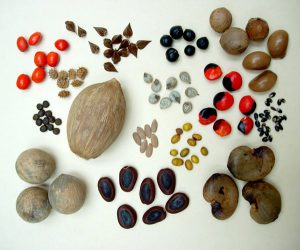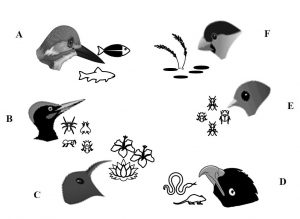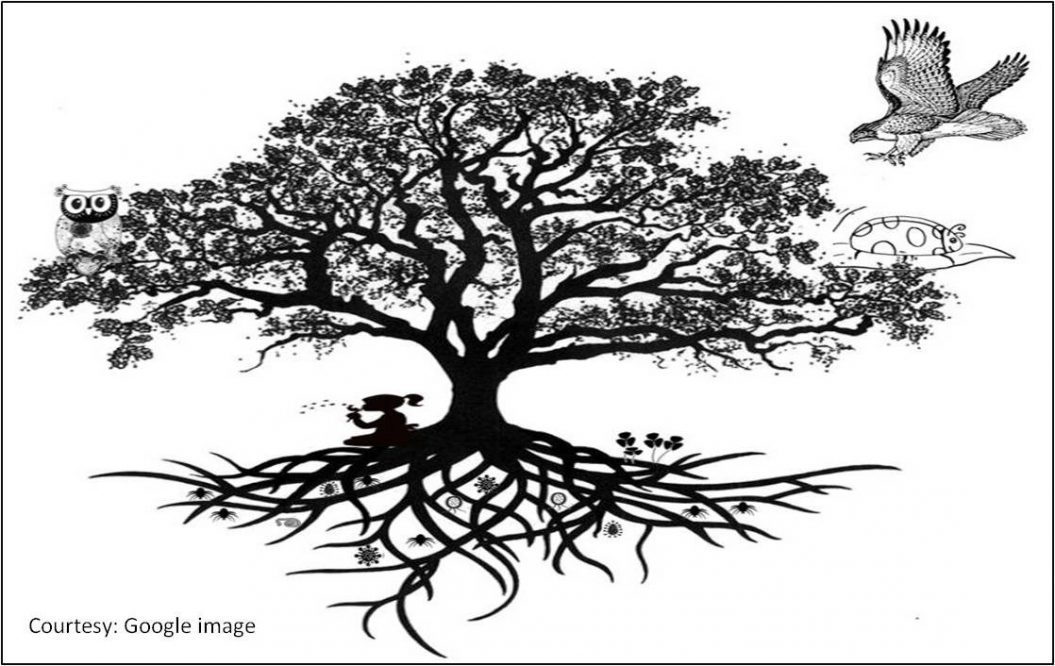A visit to the museum mesmerizes us with a fascinating set of collections; the same happens when we are in the botanical or zoological garden or seaside aquariums where a plethora of biota flaunts a glimpse of diverse culture, life forms or functions. Considering its expansion and variation, biodiversity is also comparable with these places when we mention about statistics like “374,000 species of plants” (Christenhusz and Byng 2016), “8141 species of amphibians” (https://amphibiansoftheworld.amnh.org/), “10721 species of birds” (Clements Checklist v2019) and so on. Moreover, overly mention of the terms like “rare”, “endangered”, “threatened” or “endemic” species educate common people about the treasures of the natural world and its careful maintenance. Undoubtedly, this representation of the natural world through the lens of biodiversity ignites our imagination like the world as a gorgeous Persian carpet with intricate designs, colors, and patterns. Over the years, this emphasis on variation led to a large body of scientific research and documentation work thus unfolded interesting facts on species count, distribution, functions, and response towards the environment and biotic interactions.
We can also view this rich tapestry through various life-sustaining services offered by it. Let us think about water, food, shelter, medicine even fresh air, our list of debt towards nature gets longer and longer. For example, medicine is mostly of defensive chemicals (i.e. secondary metabolites) produced by plants or other organisms to resist the entry of unwanted guests in their system. Foods are stored products from plants or the organism itself which dissipates our hunger. Even the procedure of food production is a complex interaction among landscape, resident biota, and abiotic environment. Similarly, fresh air is ensured through photosynthesis, the food-making process in plants and perennial availability of water is ensured by the forest ecosystem. Based on this product based assessment, we can say that a species-rich system is worthy to maintain due to the overwhelming flow of products. So more species mean more benefits in terms of products/functions. This association between biodiversity and ecosystem function is commonly known as Biodiversity-Ecosystem Function relationship (BEF relationship).
The BEF relationship not only prompts scientific quest, but it also has a leading role in conservation agenda across the globe. The idea of the species-rich area, hotspots and productive landscapes all are mingling around this BEF relationship with an expectation to secure our survival in the long run. So the conservation work is not merely out of philanthropy, our calculation is very much in it.
As per the BEF relationship, the linear assumption that many species many services do not work every time. There will be redundancy if many members of the same clan have nearly similar types of functions. And, if there is redundancy there is no major problem if we lose one or two species. Accordingly, if we optimize the species number as per our requirement of services or natural world dynamics our conservation efforts will be efficiently streamlined. This function-based assessment of diversity is commonly known as functional diversity, which, in the true sense, monitor or assess how functionally diverse a system is. The redundancy in species function has some theoretical explanations. One line of thought is having multiple species with the same type of functions is beneficial for ecosystem stability or resilience. Loss of one or two members may compensate by others, therefore, no significant change can be felt at ecosystem functions (Functional Redundancy). Another view is revolving around the idea of the “insurance hypothesis”. The greater the variation in responses among the species in a community, the lower the species richness required to withstand the environmental odds. Therefore, whatever perturbations will come there will be always a few species who can effectively bypass the situation (Diaz and Cadibo 2011).
After redundancy, the next question is how a species-rich system (better to say function-rich system) manages to survive when there is a limitation of resource? Before answering, lets’ say a few lines about “niche”. The word niche can be explained as “a species’ place in the environment” i.e. its’ unique way to adapt with abiotic and biotic interaction, utilization of resources, survival strategy even modification of the environment, etc. Regarding resource use, we can say that a species occupies a definite place or niche in resource use strategy. It has a specific requirement, a particular method to acquire the resource, method to avoid competition, etc. In a multi-species environment, there are many possibilities 1) they may share same resources at the same place (niche overlapping) therefore high competition; 2) there may be random accession of resources with minimal or moderate overlapping (partial niche partitioning) or 3) random accession of resources without any overlapping (niche partitioning or complementarity) so to full use of the resources. A simplified example can be drawn from the garden or forest where different types of plants are available. When grasses and small herbs are busy to explore near-surface soil layers for their nutrition and water, trees extend their roots deeper to tap the not so easily available water. In that way, the competition for water is reduced as well as the utilization of the resources is balanced. This adjustment and optimization exercise are very much conspicuous in our surroundings. Think about diverse flower types both in structure and color which cater life-sustaining services to other depending organisms and for the organism itself. Flowers have an important role in pollination which secures the initialization of reproductive activities in the plant. In the majority of cases, the success rate of pollination is crucially dependent on how well the flowers attract the visitors for what they should be at their best in terms of appearance (i.e. size and color) as well as the availability of rewards (i.e. honey, nectar, etc.). To reduce the competition and optimal use of available resources in the show business, variation strategy has come to the scenario. Flowers differ themselves in terms of color, size, and structure even flowering time to fix a definite group of visitors for pollination activity (Figure 1). The diversity in fruit type also narrates the same story. It is for successful seed dispersal plants has to develop the best carrier (i.e., fruit) for luring predators to make use of them. Therefore, like predators, fruit also offers a diverse range of members varied in size (watermelon to berries) seed numbers (one to many-seeded) and fruiting time (Figure 2). All arrangements are for catering the requirement for different groups of depending fauna as well as securing their survival in the competitive natural world. For birds, from small hummingbirds to big hawk body size differs considerably which is an indication of their energy/resource requirement. Similarly, variation in beak structure hints at birds’ dietary requirements (Figure 3).

Upper panel: flower differentiation based on shape. A. Gullet B. Bell C. Brush D. Tube E. Dish and F. Flag. Lower panel: few well known pollinators in our surroundings. a. Bat b. Bee c. Beetles d. Bird e. Butterfly f. Carrion fly g. Fly. Source: Rosas-Guerrero et al., Ecology Letters, 2014, 17:388-400
All different root types, flower, fruit characters, body sizes and beak types with definite functions have a technical term, known as “trait” or “functional trait”. The proper definition can be “Functional traits are morphological, biochemical, physiological, structural, phenological, or behavioral characteristics that are expressed in phenotypes of individual organisms and are considered relevant to the response of such organisms to the environment and/or their effects on ecosystem properties.” (Violle et al. 2007). These traits are measurable units for functional diversity. Traits are usually considered as surrogates to assess ecosystem functions and their presence in an organism represents its long history of interaction with surroundings. As a result, traits are conservative in their character and expression which is imprinted in the organisms’ genetic makeup. Traits can be categorized as “response” (those which are the outcome of the interaction with the environment, e.g. life form, seed mass, root type, etc.) and “effect” (organisms’ impact on ecosystem functions and services e.g. biomass production, nutrient cycling, etc.). Like species as a unit in taxonomic diversity assessment, traits are used in functional diversity indices, e.g. richness (how much volume is occupied in the functional space), evenness (how evenly abundance is distributed i.e. whether all traits are equally present or the system is dominated by few chosen ones) and divergence (measure of the dispersion from the center of trait range). These indices help us to assess whether the ecosystem is functionally rich or stable or under stress or showing warning signals of upcoming danger.

Globally functional diversity is an active area of research. Studies include Arctic Tundra to Amazon rainforest, interior forest to the agricultural landscape, land to marine life forms to explore the connections between organisms and their environment. Some examples can be discussed here. Giam et al. (2015) in their oil-palm plantation study in Indonesia found that maintaining a mosaic of plantation with riparian reserves is beneficial for the local fish community. This combination of landscape preserves functional diversity which benefits local livelihood in terms of fish availability and supports ecosystem functions like trophic position fulfillment, energy flow, etc. Similarly, in the Neotropics, eastern Amazonian region, the research found that disturbance to the forest leads to the prevalence of small-seeded plants over the large-seeded ones. The reason could be many but the important one is the loss of fauna responsible for the dispersal of large seeds owing to tree logging. As a consequence, both species’ existence and ecosystem function (e.g. plant-animal interaction) are in stake (Hawes et al. 2020). Leaving aside distinct ecosystems, functional studies in human-modified or associated systems (e.g., agriculture, grazing field, sacred groves) reveal the dominance of certain traits (due to preference towards certain taxa), ubiquitous presence of generalist species and loss of species-specific interactions. Flynn et al. (2009) studied the impact on functional diversity under land-use intensification in the agricultural landscape.

They pointed out a drastic reduction in functional diversity in birds and mammals in comparison to species richness however, the trend was not distinct in plant members. According to them the drastic reduction in faunal traits perhaps due to loss of functionally distinct species at a faster rate than redundant ones. Ray et al. (2017) in their assessment of functional diversity in sacred groves find that the majority of the studied groves are functionally less diverse (i.e. functional homogenization) although they are species-rich in comparison to their surroundings. Moreover, groves support a limited number of pollinators and seed dispersers, usually cosmopolitan. This generalization owes to land shrinkage, altered surroundings and invasive dominance which acts as a constraint for forest based specialist pollinators/seed dispersers. Thus species profile does not reflect the true state of biodiversity. Stuart-Smith et al. (2013) in their global study on marine reef species found that the profile of reef fish functional diversity varies over geographic gradients is distinctly different from global trend in species richness. One of the main reasons is the locations, mostly temperate regions, where there are more even abundance distributions (i.e. a greater proportion of species have moderate abundances), species with their unique trait characters contribute significantly to ecological processes. On the contrary, in species-rich tropics, despite having a large number of species and functional groups, it is due to the low abundance of functionally unique members their contribution to ecological processes is relatively weak. Likewise, many such examples can be drawn from elsewhere to establish the fact that functional diversity is a better predictor for the status of ecosystem or biodiversity than its’ taxonomic counterpart.
In conclusion, functional diversity provides an opportunity to know the importance of having so many life forms, their dependence on each other and the environment, their role in maintaining natural world dynamics and the potential to survive in recent catastrophic Anthropocene. This shift to function centric assessment of biodiversity is a timely approach to increase our in-depth understanding of biodiversity and our association with it. Hopefully, future research will show us the directions to face the challenges in cultural, ecological and economical forefronts of the planet.
Acknowledgement
Author thanks Sandeep Pulla, Balaji Chattopadhyay, and Avik Ray for their comments and suggestions on the earlier version of the manuscript.
References
- Christenhusz M.J.M and Byng J.W. (2016). The number of known plants species in the world and its annual increase. Phytotaxa 261 (3): 201–217
- Clements, J. F, Schulenberg T.S, Iliff M.J. et al. (2019). The eBird / Clements Checklist of Birds of the World: v2019. Downloaded from https://www.birds.cornell.edu/clementschecklist/download/
- Diaz S and Cadibo M. (2001). Vive la différence: plant functional diversity matters to ecosystem processes. Trends in Ecology & Evolution, 16:11, 646-666.
- Flynn D.F.B, Gogol-Prokurat M, Nogeire T. et al. (2009). Loss of functional diversity under land use intensification across multiple taxa. Ecology Letters, 12:1, 22-33, DOI:
- Giam X, Hadiaty R.K, Tan H.H. et al. (2015). Mitigating the impact of oil-palm monoculture on freshwater fishes in Southeast Asia. Conservation Biology, 29:5, 1357–1367
- Hawes J.E, Vieira I.C.G, Magnago L.F.S. et al. (2020). A large‐scale assessment of plant dispersal mode and seed traits across human‐modified Amazonian forests. Journal of Ecology, DOI: 10.1111/1365-2745.13358
- Ray Rajasri, Sreevidya E.A and Ramachandra T.V. (2017). Functional importance of sacred forest patches in the altered landscape of Palakkad region, Kerala, India. Journal of Tropical Ecology, 33:6, 379-394, DOI: 10.1017/S0266467417000360
- Stuart-Smith R.D, Bates A.E, Lefcheck J.S. et al. (2013). Integrating abundance and functional traits reveals new global hotspots of fish diversity. Nature, 501:539-544, DOI: 10.1038/nature12529
- Violle C, Navas M, Vile D. et al. (2007). Let the concept of trait be functional. Oikos, 116:5, 882-892. DOI: 10.1111/j.0030-1299.2007.15559.x
About Author :

Rajasri Ray
Centre for Studies in Ethnobiology, Biodiversity and Sustainability (CEiBa), Malda, India
e-mail: rajasri@ceibatrust.org



